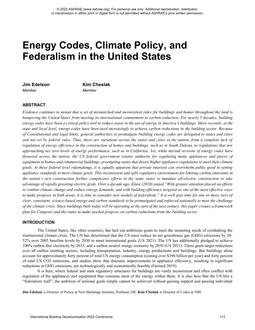
C15 — Energy Codes, Climate Policy, and Federalism in the United States
- Comments Off on C15 — Energy Codes, Climate Policy, and Federalism in the United States
- ASHRAE
Click here to purchase
Evidence continues to mount that a set of mismatched and inconsistent rules for buildings and homes throughout the land is hampering the United States from meeting its international commitment to carbon reduction. For nearly 5 decades, building energy codes have been a critical policy tool to reduce waste in the use of energy in America’s buildings. More recently, at the state and local level, energy codes have been used increasingly to achieve carbon reductions in the building sector. Because of Constitutional and legal limits, general authorities to promulgate building energy codes are delegated to states and cities and not set by federal rules. Thus, there are variations across the states and cities in the nation, from a complete lack of regulation of energy efficiency in the construction of homes and buildings, such as in South Dakota, to regulations that are approaching net zero levels of energy performance, such as in California. Yet, while myriad versions of energy codes have flowered across the nation, the US federal government retains authority for regulating many appliances and pieces of equipment in homes and commercial buildings, preempting states that desire higher appliance regulations to meet their climate goals. At these federal level rulemakings, it is equally apparent that private interests can overwhelm public good in setting appliance standards to meet climate goals. This inconsistent and split regulatory environment for limiting carbon emissions in the nation’s new construction further complicates efforts in the same states to mandate all-electric construction to take advantage of rapidly greening electric grids. Over a decade ago, Klass (2010) stated “With greater attention placed on efforts to combat climate change and reduce energy demands, and with building efficiency targeted as one of the most effective ways to make progress in both areas, it is time to consider new models of federalism.” It is well past time for one or more tiers of clear, consistent, science-based energy and carbon standards to be promulgated and enforced nationally to meet the challenge of the climate crisis. Since buildings built today will be operating at the turn of the next century, this paper creates a framework plan for Congress and the states to make needed progress on carbon reductions from the building sector.
Product Details
- Published:
- 2022
- Number of Pages:
- 8
- Units of Measure:
- Dual
- File Size:
- 1 file , 4.1 MB
- Product Code(s):
- D-94056-C15
- Note:
- This product is unavailable in Russia, Belarus

